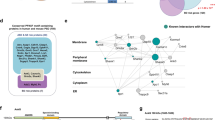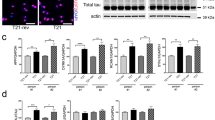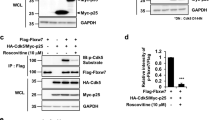Abstract
Genetic variations in the DTNBP1 gene (encoding the protein dysbindin-1) have been implicated as risk factors in the pathogenesis of schizophrenia. Previous studies have indicated that dysbindin-1 functions in the regulation of synaptic activity. Recently, dysbindin-1 has also been documented to be involved in neuronal development. In this study, we identified necdin as a binding partner of dysbindin-1 using a yeast two-hybrid screen. Dysbindin-1 recruits necdin to the cytoplasm, thereby attenuating the repressive effects of necdin on p53 transcriptional activity. Knockdown of dysbindin-1, like knockdown of p53, greatly decreases the expressions of the p53 target genes coronin 1b and rab13, which are required for neurite outgrowth. Moreover, overexpression of p53 restores the neurite outgrowth blocked by dysbindin-1 knockdown. In brains of dysbindin-1 null mice (the sandy strain), p21, Coronin 1b and Rab13 levels are reduced. Furthermore, primary cultured cortical neurons from sandy mice display neurite outgrowth defects when compared with those from wild-type mice. Thus, our data provide evidence that dysbindin-1 has an important role in neurite outgrowth through its regulation of p53’s transcriptional activity.
This is a preview of subscription content, access via your institution
Access options
Subscribe to this journal
Receive 12 print issues and online access
$259.00 per year
only $21.58 per issue
Buy this article
- Purchase on Springer Link
- Instant access to full article PDF
Prices may be subject to local taxes which are calculated during checkout





Similar content being viewed by others

References
Freedman R . Schizophrenia. N Engl J Med 2003; 349: 1738–1749.
Ross CA, Margolis RL, Reading SA, Pletnikov M, Coyle JT . Neurobiology of schizophrenia. Neuron 2006; 52: 139–153.
Riley B, Kendler KS . Molecular genetic studies of schizophrenia. Eur J Hum Genet 2006; 14: 669–680.
Schwab SG, Knapp M, Mondabon S, Hallmayer J, Borrmann-Hassenbach M, Albus M et al. Support for association of schizophrenia with genetic variation in the 6p22.3 gene, dysbindin, in sib-pair families with linkage and in an additional sample of triad families. Am J Hum Genet 2003; 72: 185–190.
Tang JX, Zhou J, Fan JB, Li XW, Shi YY, Gu NF et al. Family-based association study of DTNBP1 in 6p22.3 and schizophrenia. Mol Psychiatry 2003; 8: 717–718.
Funke B, Finn CT, Plocik AM, Lake S, DeRosse P, Kane JM et al. Association of the DTNBP1 locus with schizophrenia in a U.S. population. Am J Hum Genet 2004; 75: 891–898.
Weickert CS, Rothmond DA, Hyde TM, Kleinman JE, Straub RE . Reduced DTNBP1 (dysbindin-1) mRNA in the hippocampal formation of schizophrenia patients. Schizophr Res 2008; 98: 105–110.
Talbot K, Eidem WL, Tinsley CL, Benson MA, Thompson EW, Smith RJ et al. Dysbindin-1 is reduced in intrinsic, glutamatergic terminals of the hippocampal formation in schizophrenia. J Clin Invest 2004; 113: 1353–1363.
Fallgatter AJ, Herrmann MJ, Hohoff C, Ehlis AC, Jarczok TA, Freitag CM et al. DTNBP1 (dysbindin) gene variants modulate prefrontal brain function in healthy individuals. Neuropsychopharmacology 2006; 31: 2002–2010.
Donohoe G, Morris DW, Clarke S, McGhee KA, Schwaiger S, Nangle JM et al. Variance in neurocognitive performance is associated with dysbindin-1 in schizophrenia: a preliminary study. Neuropsychologia 2007; 45: 454–458.
Ghiani CA, Starcevic M, Rodriguez-Fernandez IA, Nazarian R, Cheli VT, Chan LN et al. The dysbindin-containing complex (BLOC-1) in brain: developmental regulation, interaction with SNARE proteins and role in neurite outgrowth. Mol Psychiatry 2010; 15: 115, 204–115.
Talbot K, Cho DS, Ong WY, Benson MA, Han LY, Kazi HA et al. Dysbindin-1 is a synaptic and microtubular protein that binds brain snapin. Hum Mol Genet 2006; 15: 3041–3054.
Numakawa T, Yagasaki Y, Ishimoto T, Okada T, Suzuki T, Iwata N et al. Evidence of novel neuronal functions of dysbindin, a susceptibility gene for schizophrenia. Hum Mol Genet 2004; 13: 2699–2708.
Iizuka Y, Sei Y, Weinberger DR, Straub RE . Evidence that the BLOC-1 protein dysbindin modulates dopamine D2 receptor internalization and signaling but not D1 internalization. J Neurosci 2007; 27: 12390–12395.
Ji Y, Yang F, Papaleo F, Wang HX, Gao WJ, Weinberger DR et al. Role of dysbindin in dopamine receptor trafficking and cortical GABA function. Proc Natl Acad Sci USA 2009; 106: 19593–19598.
Bellon A . New genes associated with schizophrenia in neurite formation: a review of cell culture experiments. Mol Psychiatry 2007; 12: 620–629.
Kamiya A, Tomoda T, Chang J, Takaki M, Zhan C, Morita M et al. DISC1-NDEL1/NUDEL protein interaction, an essential component for neurite outgrowth, is modulated by genetic variations of DISC1. Hum Mol Genet 2006; 15: 3313–3323.
Ozeki Y, Tomoda T, Kleiderlein J, Kamiya A, Bord L, Fujii K et al. Disrupted-in-schizophrenia-1 (DISC-1): mutant truncation prevents binding to NudE-like (NUDEL) and inhibits neurite outgrowth. Proc Natl Acad Sci USA 2003; 100: 289–294.
Gerecke KM, Wyss JM, Carroll SL . Neuregulin-1beta induces neurite extension and arborization in cultured hippocampal neurons. Mol Cell Neurosci 2004; 27: 379–393.
Kubota K, Kumamoto N, Matsuzaki S, Hashimoto R, Hattori T, Okuda H et al. Dysbindin engages in c-Jun N-terminal kinase activity and cytoskeletal organization. Biochem Biophys Res Commun 2009; 379: 191–195.
Feng YQ, Zhou ZY, He X, Wang H, Guo XL, Hao CJ et al. Dysbindin deficiency in sandy mice causes reduction of snapin and displays behaviors related to schizophrenia. Schizophr Res 2008; 106: 218–228.
Li W, Zhang Q, Oiso N, Novak EK, Gautam R, O’Brien EP et al. Hermansky-Pudlak syndrome type 7 (HPS-7) results from mutant dysbindin, a member of the biogenesis of lysosome-related organelles complex 1 (BLOC-1). Nat Genet 2003; 35: 84–89.
Ito H, Morishita R, Shinoda T, Iwamoto I, Sudo K, Okamoto K et al. Dysbindin-1, WAVE2 and Abi-1 form a complex that regulates dendritic spine formation. Mol Psychiatry 2010; 15: 976–986.
Starcevic M, Dell’Angelica EC . Identification of snapin and three novel proteins (BLOS1, BLOS2, and BLOS3/reduced pigmentation) as subunits of biogenesis of lysosome-related organelles complex-1 (BLOC-1). J Biol Chem 2004; 279: 28393–28401.
Harms K, Nozell S, Chen X . The common and distinct target genes of the p53 family transcription factors. Cell Mol Life Sci 2004; 61: 822–842.
Tedeschi A, Di Giovanni S . The non-apoptotic role of p53 in neuronal biology: enlightening the dark side of the moon. EMBO Rep 2009; 10: 576–583.
Zhang J, Yan W, Chen X . p53 is required for nerve growth factor-mediated differentiation of PC12 cells via regulation of TrkA levels. Cell Death Differ 2006; 13: 2118–2128.
Di Giovanni S, De Biase A, Yakovlev A, Finn T, Beers J, Hoffman EP et al. In vivo and in vitro characterization of novel neuronal plasticity factors identified following spinal cord injury. J Biol Chem 2005; 280: 2084–2091.
Di Giovanni S, Knights CD, Rao M, Yakovlev A, Beers J, Catania J et al. The tumor suppressor protein p53 is required for neurite outgrowth and axon regeneration. EMBO J 2006; 25: 4084–4096.
Tedeschi A, Nguyen T, Steele SU, Feil S, Naumann U, Feil R et al. The tumor suppressor p53 transcriptionally regulates cGKI expression during neuronal maturation and is required for cGMP-dependent growth cone collapse. J Neurosci 2009; 29: 15155–15160.
Moore DL, Blackmore MG, Hu Y, Kaestner KH, Bixby JL, Lemmon VP et al. KLF family members regulate intrinsic axon regeneration ability. Science 2009; 326: 298–301.
MacGillavry HD, Stam FJ, Sassen MM, Kegel L, Hendriks WT, Verhaagen J et al. NFIL3 and cAMP response element-binding protein form a transcriptional feedforward loop that controls neuronal regeneration-associated gene expression. J Neurosci 2009; 29: 15542–15550.
Benson MA, Tinsley CL, Blake DJ . Myospryn is a novel binding partner for dysbindin in muscle. J Biol Chem 2004; 279: 10450–10458.
Takazaki R, Nishimura I, Yoshikawa K . Necdin is required for terminal differentiation and survival of primary dorsal root ganglion neurons. Exp Cell Res 2002; 277: 220–232.
Hu B, Wang S, Zhang Y, Feghali CA, Dingman JR, Wright TM . A nuclear target for interleukin-1alpha: interaction with the growth suppressor necdin modulates proliferation and collagen expression. Proc Natl Acad Sci USA 2003; 100: 10008–10013.
Kuwajima T, Nishimura I, Yoshikawa K . Necdin promotes GABAergic neuron differentiation in cooperation with Dlx homeodomain proteins. J Neurosci 2006; 26: 5383–5392.
Liu X, Wang Y, Zhang Y, Zhu W, Xu X, Niinobe M et al. Nogo-A inhibits necdin-accelerated neurite outgrowth by retaining necdin in the cytoplasm. Mol Cell Neurosci 2009; 41: 51–61.
Taniura H, Matsumoto K, Yoshikawa K . Physical and functional interactions of neuronal growth suppressor necdin with p53. J Biol Chem 1999; 274: 16242–16248.
Taniura H, Taniguchi N, Hara M, Yoshikawa K . Necdin, a postmitotic neuron-specific growth suppressor, interacts with viral transforming proteins and cellular transcription factor E2F1. J Biol Chem 1998; 273: 720–728.
Sherr CJ, Roberts JM . CDK inhibitors: positive and negative regulators of G1-phase progression. Genes Dev 1999; 13: 1501–1512.
Pechnick RN, Zonis S, Wawrowsky K, Pourmorady J, Chesnokova V . p21Cip1 restricts neuronal proliferation in the subgranular zone of the dentate gyrus of the hippocampus. Proc Natl Acad Sci USA 2008; 105: 1358–1363.
Benson MA, Newey SE, Martin-Rendon E, Hawkes R, Blake DJ . Dysbindin, a novel coiled-coil-containing protein that interacts with the dystrobrevins in muscle and brain. J Biol Chem 2001; 276: 24232–24241.
Brynczka C, Labhart P, Merrick BA . NGF-mediated transcriptional targets of p53 in PC12 neuronal differentiation. BMC Genomics 2007; 8: 139.
Bani-Yaghoub M, Amundsen DE . Study and simulation of reaction-diffusion systems affected by interacting signaling pathways. Acta Biotheor 2008; 56: 315–328.
Wu PY, Lin YC, Chang CL, Lu HT, Chin CH, Hsu TT et al. Functional decreases in P2X7 receptors are associated with retinoic acid-induced neuronal differentiation of neuro-2a neuroblastoma cells. Cell Signal 2009; 21: 881–891.
Maruyama K, Usami M, Aizawa T, Yoshikawa K . A novel brain-specific mRNA encoding nuclear protein (necdin) expressed in neurally differentiated embryonal carcinoma cells. Biochem Biophys Res Commun 1991; 178: 291–296.
Uetsuki T, Takagi K, Sugiura H, Yoshikawa K . Structure and expression of the mouse necdin gene. Identification of a postmitotic neuron-restrictive core promoter. J Biol Chem 1996; 271: 918–924.
Jay P, Rougeulle C, Massacrier A, Moncla A, Mattei MG, Malzac P et al. The human necdin gene, NDN, is maternally imprinted and located in the Prader-Willi syndrome chromosomal region. Nat Genet 1997; 17: 357–361.
MacDonald HR, Wevrick R . The necdin gene is deleted in Prader-Willi syndrome and is imprinted in human and mouse. Hum Mol Genet 1997; 6: 1873–1878.
Taniura H, Kobayashi M, Yoshikawa K . Functional domains of necdin for protein-protein interaction, nuclear matrix targeting, and cell growth suppression. J Cell Biochem 2005; 94: 804–815.
Kurita M, Kuwajima T, Nishimura I, Yoshikawa K . Necdin downregulates CDC2 expression to attenuate neuronal apoptosis. J Neurosci 2006; 26: 12003–12013.
Midgley CA, Owens B, Briscoe CV, Thomas DB, Lane DP, Hall PA . Coupling between gamma irradiation, p53 induction and the apoptotic response depends upon cell type in vivo. J Cell Sci 1995; 108 (Pt 5): 1843–1848.
Clarke AR, Gledhill S, Hooper ML, Bird CC, Wyllie AH . p53 dependence of early apoptotic and proliferative responses within the mouse intestinal epithelium following gamma-irradiation. Oncogene 1994; 9: 1767–1773.
Komarova EA, Chernov MV, Franks R, Wang K, Armin G, Zelnick CR et al. Transgenic mice with p53-responsive lacZ: p53 activity varies dramatically during normal development and determines radiation and drug sensitivity in vivo. EMBO J 1997; 16: 1391–1400.
Gottlieb E, Haffner R, King A, Asher G, Gruss P, Lonai P et al. Transgenic mouse model for studying the transcriptional activity of the p53 protein: age- and tissue-dependent changes in radiation-induced activation during embryogenesis. EMBO J 1997; 16: 1381–1390.
Armstrong JF, Kaufman MH, Harrison DJ, Clarke AR . High-frequency developmental abnormalities in p53-deficient mice. Curr Biol 1995; 5: 931–936.
Sakane A, Honda K, Sasaki T . Rab13 regulates neurite outgrowth in PC12 cells through its effector protein, JRAB/MICAL-L2. Mol Cell Biol 2010; 30: 1077–1087.
Cai L, Marshall TW, Uetrecht AC, Schafer DA, Bear JE . Coronin 1B coordinates Arp2/3 complex and cofilin activities at the leading edge. Cell 2007; 128: 915–929.
Beneyto M, Lewis DA . Insights into the neurodevelopmental origin of schizophrenia from postmortem studies of prefrontal cortical circuitry. Int J Dev Neurosci 2010; doi:10.1016/j.ijdevneu.2010.08.003.
Read DE, Gorman AM . Involvement of Akt in neurite outgrowth. Cell Mol Life Sci 2009; 66: 2975–2984.
Acknowledgements
This work was supported, in part, by the National Natural Sciences Foundation of China (no. 30770664 and 30970921) and the CAS Knowledge Innovation Project (KSCX2-YW-R138).
Author information
Authors and Affiliations
Corresponding author
Ethics declarations
Competing interests
The authors declare no conflict of interest.
Additional information
Supplementary Information accompanies the paper on the Molecular Psychiatry website
Supplementary information
Rights and permissions
About this article
Cite this article
Ma, X., Fei, E., Fu, C. et al. Dysbindin-1, a schizophrenia-related protein, facilitates neurite outgrowth by promoting the transcriptional activity of p53. Mol Psychiatry 16, 1105–1116 (2011). https://doi.org/10.1038/mp.2011.43
Received:
Revised:
Accepted:
Published:
Issue Date:
DOI: https://doi.org/10.1038/mp.2011.43
Keywords
This article is cited by
-
Schizophrenia risk ZNF804A interacts with its associated proteins to modulate dendritic morphology and synaptic development
Molecular Brain (2021)
-
KLF4 Exerts Sedative Effects in Pentobarbital-Treated Mice
Journal of Molecular Neuroscience (2021)
-
DISC1 causes associative memory and neurodevelopmental defects in fruit flies
Molecular Psychiatry (2016)
-
Altered expression of mRNA profiles in blood of early-onset schizophrenia
Scientific Reports (2016)
-
Increased dysbindin-1B isoform expression in schizophrenia and its propensity in aggresome formation
Cell Discovery (2015)


